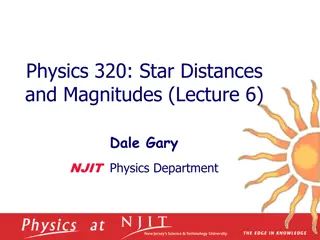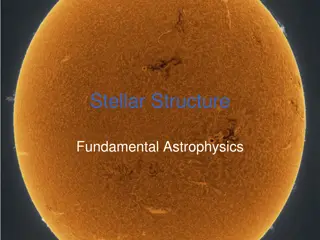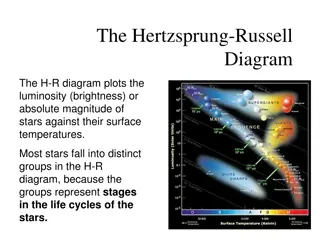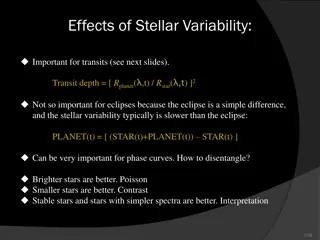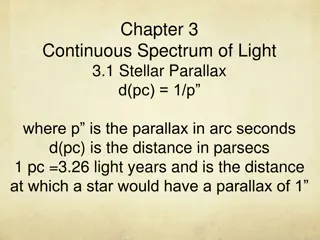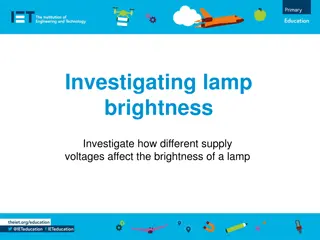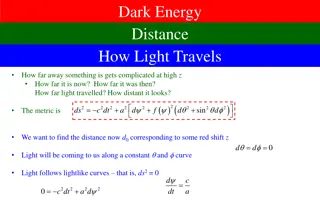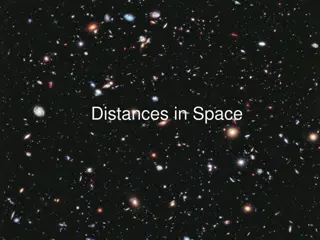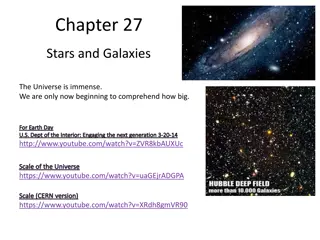Understanding Stellar Brightness and Magnitude Distances
Explore the relationship between a star's brightness as observed from Earth and its actual brightness, distance, apparent magnitude, and absolute magnitude. Learn how to calculate these values using data and formulas. Gain insights into the variations in star distances, brightness, and magnitudes to deepen your understanding of stellar properties.
Download Presentation

Please find below an Image/Link to download the presentation.
The content on the website is provided AS IS for your information and personal use only. It may not be sold, licensed, or shared on other websites without obtaining consent from the author. Download presentation by click this link. If you encounter any issues during the download, it is possible that the publisher has removed the file from their server.
E N D
Presentation Transcript
Betelgeuse Castor Rigel Pollux Procyon Sirius
Recording Brightness From Earth 33 light years (312,200,000,000,000 km) Recording Actual Brightness Light Year: The distance that light can travel in one year (9,490,700,000,000 km)
Learning Objectives: Students will be able to use data to support the claim that a star s brightness as observed from Earth is a function of both distance and actual brightness. Disciplinary Core Idea: ESS1.A The Universe and its Stars The Sun is a star that appears larger and brighter than other stars because it is closer. Stars range greatly in their distances from Earth. Science and Engineering Practice: #2 Engaging in Argument from Evidence Engaging in argument from evidence in 3-5 builds on K-2 experience and progresses to critiquing the scientific explanations of solution proposed by peers by citing relevant evidence about the natural and designed world(s). Supporting an argument with evidence, data, or a model. Cross Cutting Concept: #3 Scale, Proportion, and Quantity Natural objects exist from the very small to the immensely large.
Teacher Slide Not For Students Apparent Magnitude (similar to brightness from Earth) Apparent Magnitude (m): A measure of the brightness of a celestial object as seen by someone on Earth. Apparent Magnitudes were first measured by a Greek astronomer Hipparchus in ~150 BC. He set the scale for the brightest stars to be 0 and the dimmest starts to be 6. Therefore, the brighter the star the lower the apparent magnitude. Hipparchus though Vega was the brightest star so he set that to 0. There are brighter stars than Vega so some stars have negative apparent magnitude. Apparent magnitude is calculated with: ?? ??,0= 2.5??? m is the apparent magnitude F is the flux density (energy (power of radiation) per unit area) this can be measured mx,0 is the apparent magnitude of the reference object, Vega, (??,?= 0) Fx,0 is the reference flux. You find this by pointing your photometer at Vega with the appropriate filter and making your measurement Apparent Magnitude is on a logarithmic scale, like earthquakes (see table). Apparent magnitude can be done in the ultraviolet, visible, or infrared wavelengths. ?? ??,0 How much brighter the brighter star will be m2-m1 1 2.51 (2.51)2 = 6.31 2 (2.51)3 = 15.85 3 For the Activity the Brightness from Earth is Negative of the Apparent Magnitude (2.51)4 = 39.82 4 (2.51)2 = 100 5
Teacher Slide Not For Students Absolute Magnitude (similar to actual brightness) Absolute Magnitude (M): A measure of the brightness of a celestial object 32.6 ly (10 parsecs) from the object, the brighter an object is the lower the absolute magnitude. If you know the distance of the object and the apparent magnitude you can calculate the absolute magnitude because we know how flux changes with distance. ? 10 ?? d is distance (must be in parsecs), m is apparent magnitude, and M is absolute magnitude 3.4 ?? 10 ?? = 2.6 2 ? = ? 2.5??? 2 For Procyon ? = 0.3 2.5??? For the Activity the Actual Brightness is Negative of the Absolute Magnitude
Teacher Slide Not For Students Determining Distance to Stars Parallax: A effect whereby the position or direction of an object appears to different when viewed from different positions Measure how much a star seems to move at two different times in the year The farther out the object, the harder this method is and if the object is too far (over 325 ly) this method cannot be used Standard Candles: Objects of know brightness Cepheid stars are a type of star that s brightness varies in a well defined periodic manner (from a few hours to a few days) due to the stars envelope expanding and contracting How fast they pulsate is proportional to the temperature The temperature is proportional to the actual brightness Brightness equations can be used to calculate distance Doppler Affect: Increase or decreases in the frequency of sound/light waves as the source and the observer move away The closer the object is to Earth the less red shift it will have. The universe is expanding so all objects are moving away from each other. If you know the wavelength the object should be. You can use the change in wavelength to calculate the distance






